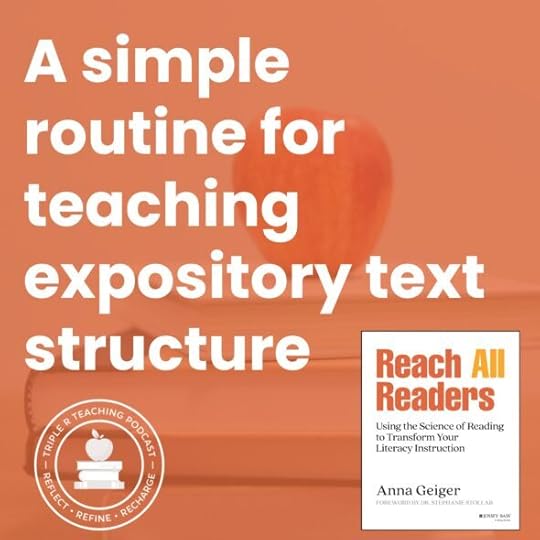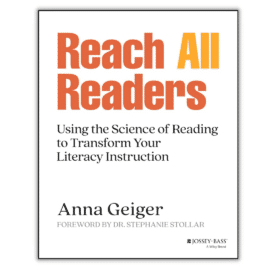A simple routine for teaching expository text structure
 ��TRT Podcast 176: A simple routine for teaching expository text structure
��TRT Podcast 176: A simple routine for teaching expository text structureUse this simple routine to teach any of the expository text structures: sequence, description, cause and effect, compare and contrast, or problem and solution.
Listen to the episode here��Full episode transcriptTranscript
Download
New Tab
Hello, this is Anna Geiger from The Measured Mom, and this is the seventh in a series of short, to-the-point podcast episodes counting down to the release of my book, "Reach All Readers," coming soon on July 23rd, 2024. Today I'm sharing an excerpt from chapter eight, the comprehension chapter. I'm going to share a powerful routine for teaching text structure.
Before I do that, I want to share a quick endorsement from Brent Conway, Assistant Superintendent of Pentucket Regional School District. He generously read the book and offered this endorsement,
"Anna has been able to capture the complexities of implementing the science of reading and make it seem simple and tangible to any educator who wants to make a difference in the lives of their students. This will make a perfect book study text for schools and teachers across the country."
Thank you so much, Brent, for that very kind endorsement.
Now we'll get into text structure. We know there's narrative text structure, which has to do with understanding story elements, and then there's expository text structure where kids understand how informational text is organized.
When we think about expository text structure, there are five main kinds that we want to teach our students. These are description, sequence, cause and effect, compare and/or contrast, and then problem and solution.
In the book, I have a detailed table that lists all of those, describes them, includes possible signal words, gives you prompts that you can ask as you help students understand those structures, and also provides some graphic organizers.
Right now we're going to go into a routine that you can use to teach any of these text structures. I'm going to walk you through a text structure lesson that I recently gave to a group of second graders.
The teacher told me that one of the topics they'd been studying in science was animal habitats, so I wrote a passage about beavers and how they build their dams and lodges. This was organized with the sequence text structure because we went in order from first to last, including all the steps that they followed to build their lodges. I brought that to the class and we did multiple things with it.
First, I took it and I introduced it to them. I said, "Today you're going to learn a certain way that authors might organize their text, and this text structure is called sequence. You're going to read about the steps that beavers take to build their lodges from first to last."
Then we did a choral read of the text. We all read it together. You could also have students read it in pairs or choral read it in pairs.
After we were done reading the text, I had them identify the signal words. We walked through it and we found things like first, next, then, finally, and then they highlighted those in their passage.
The next thing we did was build comprehension, so I asked questions about the text. I actually was able to incorporate another strategy here, the QAR method, question-answer relationship, where you think about where the answers came from. So the answer could be right there in the text, or the answer could be something where you have to think and search and put pieces of information together. An answer could be author and me, where you think about what the author has shared and combine that with your own thoughts. Then finally, an answer could be on my own, where you're not even using the text to answer the question.
So I asked questions like, what's the first step when a beaver builds their home? What are other animals that put a lot of effort into building their homes? That would be an on my own, for example. I asked a question, what problem do you think that beavers' lodges can create for people who live in the area? That would be an author and me. They had to use the text, but they had to add to that what they already know.
As they answered those questions, we identified what types of questions they were. We didn't have time for this in our lesson, but if you're doing this with your students and you have more time, you could have them form questions about the passage to ask a partner, and then the partner could form a question to ask them.
The last thing we did was complete a graphic organizer together. I put a very simple sequence graphic organizer up on the screen, and they had a copy at their own desk. We walked through all the steps and we wrote those in the graphic organizer.
After we'd written each of the steps, we went back and added those signal words, and then we read it all as a whole paragraph.
That's a routine you can use to teach text structure. There's SO much more in my chapter on comprehension, including a great deal about sentence comprehension. I talk about the importance of building knowledge, but I also talk about the comprehension strategies that we know make the most difference.
If you'd like to pre-order the book, you can get it wherever books are sold, Amazon, Barnes & Noble, Target, Bookshop, BAM!, or Thriftbooks. Thanks so much for listening, and I'll talk to you next time!
That's all for this episode of Triple R Teaching. For more educational resources, visit Anna at her home base, themeasuredmom.com, and join our teaching community. We look forward to helping you reflect, refine, and recharge on the next episode of Triple R Teaching.
Scroll back to top
Sign up to receive email updates
Enter your name and email address below and I'll send you periodic updates about the podcast.
powered by
Pre-order my new book and get a FREE bonus!

You’ll love this reader-friendly guide to the science of reading! Learn how to put the research into action so you can reach ALL readers. Pre-order before July 23 and get my Science of Reading Mini-Course – FREE!
PRE-ORDER NOW
The post A simple routine for teaching expository text structure appeared first on The Measured Mom.
Anna Geiger's Blog
- Anna Geiger's profile
- 1 follower



